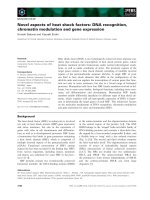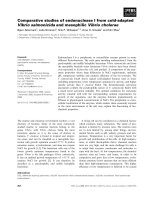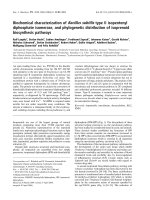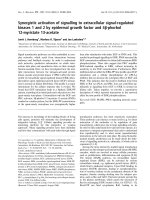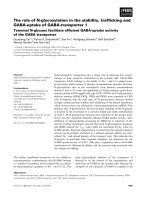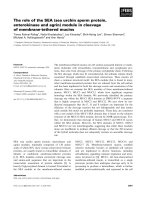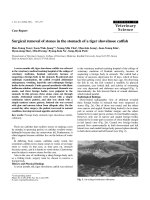Báo cáo khoa học: "Surgical management of giant Brunner''''s gland hamartoma: case report and literature review" ppsx
Bạn đang xem bản rút gọn của tài liệu. Xem và tải ngay bản đầy đủ của tài liệu tại đây (1017.65 KB, 4 trang )
BioMed Central
Page 1 of 4
(page number not for citation purposes)
World Journal of Surgical Oncology
Open Access
Case report
Surgical management of giant Brunner's gland hamartoma: case
report and literature review
Zoe A Stewart
1
, Ralph H Hruban
2
, Elliot F Fishman
3
and
Christopher L Wolfgang*
1
Address:
1
Department of Surgery, The Sol Goldman Pancreatic Cancer Research Center, Johns Hopkins Hospital, Baltimore, Maryland, USA,
2
Department of Pathology, The Sol Goldman Pancreatic Cancer Research Center, Johns Hopkins Hospital, Baltimore, Maryland, USA and
3
Department of Radiology, The Sol Goldman Pancreatic Cancer Research Center, Johns Hopkins Hospital, Baltimore, Maryland, USA
Email: Zoe A Stewart - ; Ralph H Hruban - ; Elliot F Fishman - ;
Christopher L Wolfgang* -
* Corresponding author
Abstract
Brunner's gland hamartomas (BGH) are uncommon benign tumors of the duodenum forming
mature Brunner's glands. We report here an unusual case of a giant BGH that was not amenable
to endoscopic or surgical local resection thus requiring a pancreaticoduodenectomy for
extirpation. The relevant literature is discussed.
Background
Brunner's gland hamartomas (BGH) are uncommon
benign tumors of the duodenum forming mature Brun-
ner's glands. BGH have an estimated incidence of < 0.01%
based upon review of one large autopsy series [1], and
fewer than 200 cases have been reported in the English lit-
erature. These rare tumors have a low propensity for
malignant transformation but can be confused with
lesions of more oncological importance such as dysplastic
duodenal adenomas or duodenal adenocarcinomas.
Essentially all BGH can be managed endocscopically
while duodenal adenocarcinoma requires more aggressive
intervention. Thus recognition of BGH and differentiation
from malignant tumors is critical for appropriate treat-
ment. We report here an unusual case of a giant BGH that
was not amenable to endoscopic or surgical local resec-
tion thus requiring a pancreaticoduodenectomy for extir-
pation.
Case presentation
A 62-year-old Asian male presented to an outside institu-
tion with chief complaints of epigastric abdominal pain
and reflux symptoms. Review of systems, past medical his-
tory, physical exam, and laboratory values were unre-
markable. Family history was notable for pancreatic
cancer in his father at the age of 92 years. An upper gas-
trointestinal contrast study was obtained and revealed a 6
cm mass within the duodenum that resulted in significant
compromise of the lumen. A computed tomography (CT)
scan demonstrated a cystic and solid lesion located within
the duodenum and impinging on the head of the pan-
creas. Esophagoduodensocopy (EGD) and endoscopic
ultrasound (EUS) demonstrated a submucosal, cystic
lesion in the wall of the duodenum distal to the ampulla
of Vater. The patient underwent an endoscopic ultrasound
with multiple biopsies and fluid aspirations. Microscopic
evaluation revealed benign glandular cells with reactive
changes. No malignant cells were identified. Endoscopic
Published: 2 September 2009
World Journal of Surgical Oncology 2009, 7:68 doi:10.1186/1477-7819-7-68
Received: 6 June 2009
Accepted: 2 September 2009
This article is available from: />© 2009 Stewart et al; licensee BioMed Central Ltd.
This is an Open Access article distributed under the terms of the Creative Commons Attribution License ( />),
which permits unrestricted use, distribution, and reproduction in any medium, provided the original work is properly cited.
World Journal of Surgical Oncology 2009, 7:68 />Page 2 of 4
(page number not for citation purposes)
un-roofing of the cystic lesion was performed. Clear vis-
cous fluid was noted to emanate from the lesion and
again pathology demonstrated only benign glandular
cells with reactive changes. Despite this procedure the
mass was noted to recur and grow in size over the next
three 3 years. Over this time the patient did not experience
vomiting or weight loss but did have significant worsen-
ing of his reflux symptoms.
The patient was referred to our institution and evaluated
by a multidisciplinary gastrointestinal oncology team. CT
imaging at that time demonstrated a massive intraluminal
mass extending from the antrum through the duodenum
(Figure 1). Based on this finding and previous failed
attempts at endoscopic management it was decided that
this tumor could not be resected endoscopically. He was
offered surgical exploration and resection. Preoperatively,
it was felt that this lesion could be removed through a
trans-duodenal local resection. At operation the tumor
was found to have a broad-based attachment to the duo-
denal wall and a local excision was not possible (Figure
2). The patient underwent a pancreaticoduodenectomy.
Surgical reconstruction was performed with a Peng end-
to-end binding pancreaticojejunostomy as previously
described [2] with the exception of placement of a 3.5
French plastic pediatric feeding tube as a pancreatic stent
[3]. Three 10-mm Jackson-Pratt silicone drains were left at
the pancreaticojejunostomy and hepaticojejunostomy
anastomoses as previously described [3]. The patient
advanced to a regular diet by postoperative day (POD) 6
but had amylase-rich drain output of less than 200 millili-
ters per day. As a result of the high-output postoperative
pancreatic fistula, the patient was maintained on a low-fat
diet and discharged home POD 19 with the drain that was
removed in clinic POD 34.
Pathologic examination demonstrated a Brunner's gland
hamartoma measuring 10.5 cm (Figure 3). No dysplasia
or malignancy was seen within the entirety of the speci-
men. The lesion was composed of back to back mature
Brunner's glands.
Discussion
Brunner's glands are alkaline-secreting glands located in
the submucosal layer of the duodenum. The majority of
Brunner's glands are located in the first portion of the
duodenum, with decreasing prevalence in the second and
third portions of the duodenum. BGH follow this distri-
bution, as a series of 27 patients with BGH found 70% in
the duodenal bulb, 26% in the second portion of the duo-
denum, and 4% in the third portion [4]. As BGH grow
they typically form polypoid, pedunculated masses. BGH
has equivalent gender and race distribution with the age
of presentation typically in the fifth or sixth decade of life.
BGH is often an incidental finding during EGD or imag-
ing studies as the majority of patients are asymptomatic.
In symptomatic patients, clinical manifestations can
include gastrointestinal bleeding, duodenal obstruction,
abdominal pain, ampullary obstruction, or intussuscep-
tion [4,5]. Chronic low-grade hemorrhage may lead to
iron deficiency anemia [6]. At least one instance of a BGH
Appearance of a Giant Brunner's Gland Hamartoma on Computed Tomography ScanFigure 1
Appearance of a Giant Brunner's Gland Hamartoma on Computed Tomography Scan. (a) Contrast enhanced
axial image in arterial phase of acquisition demonstrates an approximately 10 cm mass in duodenum extending into the gastric
antrum (white arrow) with both solid (yellow arrow) and cystic components (blue arrow) (b) coronal display shows the intra-
luminal nature of the mass (white arrow) and its extent as well as again defining both the solid (yellow arrow) and cystic com-
ponents (blue arrow).
World Journal of Surgical Oncology 2009, 7:68 />Page 3 of 4
(page number not for citation purposes)
causing pancreatitis, presumably due to obstruction of the
Ampula of Vater, has been reported [7].
Differential diagnosis includes duplication cyst, leiomy-
oma, leiomyosarcoma, adenoma or adenocarcinoma,
lymphoma, carcinoid tumors, heterotopic pancreatic or
gastric tissue, or gastrointestinal stromal tumors. Patho-
logic review demonstrates the admixture of normal tissues
including Brunner's glands, ducts, adipose tissue, and
lymphoid tissue [4]. The cells have uniform nuclei and
significant dysplasia is not seen. The pathogenesis of BGH
remains unclear. It has been hypothesized that BGH is
related to hyperacidity with compensatory growth of the
alkaline-secreting Brunner's glands[5] or to Helicobacter
pylori infection [8]. However, given the low incidence of
these tumors, definitive studies into the etiology are lack-
ing.
The description of BGH on computed tomography in the
literature, particularly in the era of multi-slice helical CT
scanners has been limited but varies from homogenous
enhancement with intravenous contrast administration to
heterogenous lesions with solid and cystic components
[9]. EUS examination clearly demonstrates the submu-
cosal origin of BGH and typically demonstrates heteroge-
nous lesions with solid and cystic components [10].
There have been rare reports of malignant transformation
of BGH in the literature. Brookes et al recently described a
patient who presented with gastrointestinal bleeding sec-
ondary to a 2 cm BGH [11]. The lesion was removed
endoscopically and final pathology revealed BGH with
multiple foci of dysplasia [11]. These reports suggest that
caution must be used when deciding on treatment algo-
rithms for patients with presumed BGH as the potential
for malignant transformation cannot be excluded.
Biopsies are typically indeterminate given the submucosal
location of the lesions. Treatment options can include
endoscopic removal for those lesions on a pedunculated
stalk [5,8] to surgical resection for giant broad-based
lesions [12]. The benign nature of BGH, and in most cases
the lack of significant symptoms, makes endoscopic man-
agement of these patients the preferred initial mode of
therapy. However, if endoscopic interventions fail surgical
resection may be necessary in symptomatic patients or
those in whom a malignancy is suspected. In the current
case report, our patient was experiencing significant reflux
symptoms and an attempt and endoscopic un-roofing was
unsuccessful. We therefore planned to perform a trans-
duodenal polypectomy. At operation, we found the lesion
to have a broad-based stalk not amenable to this plan and
a location that did not allow a duodenal sleeve resection.
Moreover, the massive size and ulcerated appearance
raised our level of concern of occult malignant degenera-
tion. We therefore proceeded to perform a pancreaticodu-
odenectomy. This would seem to be a very unusual
circumstance. Indeed, only two cases of a resection of
BGH by pancreaticoduodenectomy have been reported in
the literature [13,14]. In both cases the authors were con-
cerned with malignancy. Similar to our case malignancy
was not identified on final pathology.
Competing interests
The authors declare that they have no competing interests.
Authors' contributions
ZAS contributed to the study design, manuscript prepara-
tion and editing. RHH contributed to the evaluation of
Pancreaticoduodenectomy Specimen with a Giant Brunner's Gland HamartomaFigure 2
Pancreaticoduodenectomy Specimen with a Giant
Brunner's Gland Hamartoma.
Histopathological Appearance of a Giant Brunner's Gland Hamartoma stained with Hematoxylin and Eosin and viewed at 10×Figure 3
Histopathological Appearance of a Giant Brunner's
Gland Hamartoma stained with Hematoxylin and
Eosin and viewed at 10×.
Publish with BioMed Central and every
scientist can read your work free of charge
"BioMed Central will be the most significant development for
disseminating the results of biomedical research in our lifetime."
Sir Paul Nurse, Cancer Research UK
Your research papers will be:
available free of charge to the entire biomedical community
peer reviewed and published immediately upon acceptance
cited in PubMed and archived on PubMed Central
yours — you keep the copyright
Submit your manuscript here:
/>BioMedcentral
World Journal of Surgical Oncology 2009, 7:68 />Page 4 of 4
(page number not for citation purposes)
the histopathology, manuscript preparation and editing.
EKF contributed to the interpretation of the cross-sec-
tional images, manuscript preparation and editing. CLW
contributed to the study design, manuscript preparation
and final editing. All authors read and approved the final
manuscript.
Consent
Written informed consent was obtained from the patient
for publication of this case report and accompanying
images. A copy of the written consent is available for
review by the Editor-in-Chief of this journal.
References
1. Rocco A, Borriello P, Compare D, De Colibus P, Pica L, Iacono A,
Nardone G: Large Brunner's gland adenoma: Case report and
literature review. World J Gastroenterol 2006, 12:1966-1968.
2. Peng S, Yiping M, Xiujun C, Peng C: Binding pancreaticojejunos-
tomy is a new technique to minimize leakage. Am J Surg 2002,
183:283-285.
3. Winter JM, Cameron JL, Campbell KA, Chang DC, Riall TS, Schulick
RD, Choti MA, Coleman J, Hodgin MB, Sauter PK, Sonnenday CJ,
Wolfgang CL, Marohn MR, Yeo CJ: Does pancreatic duct stenting
decrease the rate of pancreatic fistula following a pancreati-
coduodenectomy? Results of a prospective randomized trial.
J Gastrointes Surg 2006, 10:1280-1290.
4. Levine JA, Burgart LJ, Batts KP, Wang KK: Brunner's gland hamar-
tomas: clinical presentation and pathological features of 27
cases. Am J Gastroenterol 1995, 90:290-294.
5. Jansen JM, Stuifbergen WN, Van Milligen AW: Endoscopic resec-
tion of a large Brunner's gland adenoma. Neth J Med 2002,
60:253-255.
6. Zangara J, Kushner H, Drachenberg C, Daly B, Flowers J, Fantry G:
Iron deficiency anemia due to a Brunner's gland hamartoma.
J Clin Gastroenterol 1998, 27:353-6.
7. Stermer E, Elias N, Keren D, Rainis T, Goldstein O, Lavy A: Acute
pancreatitis and upper gastrointestinal bleeding as present-
ing symptoms of a duodenal Brunner's gland hamartoma.
Can J Gastroenterol 2006, 20:541-2.
8. Kurella R, Ancha H, Hussain S, Lightfoot S, Harty R: Evolution of
Brunner Gland Hamartoma Associated with Helicobacter
pylori Infection. Southern Medical Association 2008, 101:648-50.
9. Patel ND, Levy AD, Mehrotra AK, Sobin LH: Brunner's gland
hyperplasia and hamartoma: Imaging features and clinico-
pathologic correlation. Am J Rad 2006, 187:715-722.
10. Hizawa K, Iwai K, Esaki M, Suekane H, Inuzuka S, Matsumoto T, Yao
T, Iida M: Endosonographic features of Brunner's gland
hamartomas which were subsequently resected endoscopi-
cally. Endoscopy 2002, 34:956-958.
11. Brookes MJ, Manjunatha S, Allen CA, Cox M: Malignant potential
in a Brunner's gland hamartoma. Postgrad Med J 2003,
79:416-417.
12. Janes SE, Zaitoun AM, Catton JA, Aithal GP, Beckingham IJ: Brun-
ner's gland hyperplasia at the ampulla of Vater. J Postgrad Med
2006, 52:38-40.
13. Lee W, Yang H, Lee Y, Jung S, Choi G, Go H, Kim A, Cha S: Runner's
Gland Hyperplasia: Treatment of Severe Diffuse Nodular
Hyperplasia Mimicking a Malignancy on Pancreatic-Duode-
nal Area. J Korean Med Sci 2008, 23:540-3.
14. Iusco D, Roncoroni L, Violi V, Donadei E, Sarli L: Brunner's gland
hamartoma: 'over treatment' of a voluminous mass simulat-
ing a malignancy of the pancreatic-duodenal area. JOP 2005,
6:348-53.
